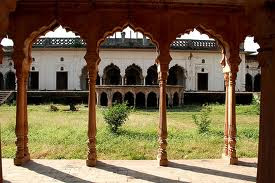The
Hindola Mahal (In English:
“Swinging Palace”), is a large meeting hall, or durbar, in the ancient
Indian city of Mandu, Madhya Pradesh. Today the Hindola Mahal is a tourist
destination in the ruined city.
The
Hindola Mahal might have been constructed during the reign of Hoshang Shah
about 1425 C.E. but may date to the end of the 15th century during the reign of
Ghiyas al-Din. It is one of a set buildings making up the royal palace complex
at Mandu, which consists of the Jahaz Mahal, the Hindola Mahal, the Tawili
Mahal, and the Nahar Jharokha. The Hindola Mahal may have been used as an
audience chamber.
The
palace attraction is a "T"- shaped building, with a main hall and a
transverse projection at the North. There are six arched openings on both sides
of the hall having windows on top, filled with beautiful tracery work providing
path to light and air to come in. Side walls are further strengthened with massive
slopes to counteract the force of the lofty arches which once supported the
huge ceiling at the top. Its "T"- shaped projection was later added
to provide a well-guarded approach for the king. The Interior of Hindola Mahal
is planned like a cross formed by the main passage leading to the hall and by
another passage crossing it at right angles in the mid passages. Mix of the
materials used at different parts of the building suggests that the
architectural additions are done at various intervals of time.
















